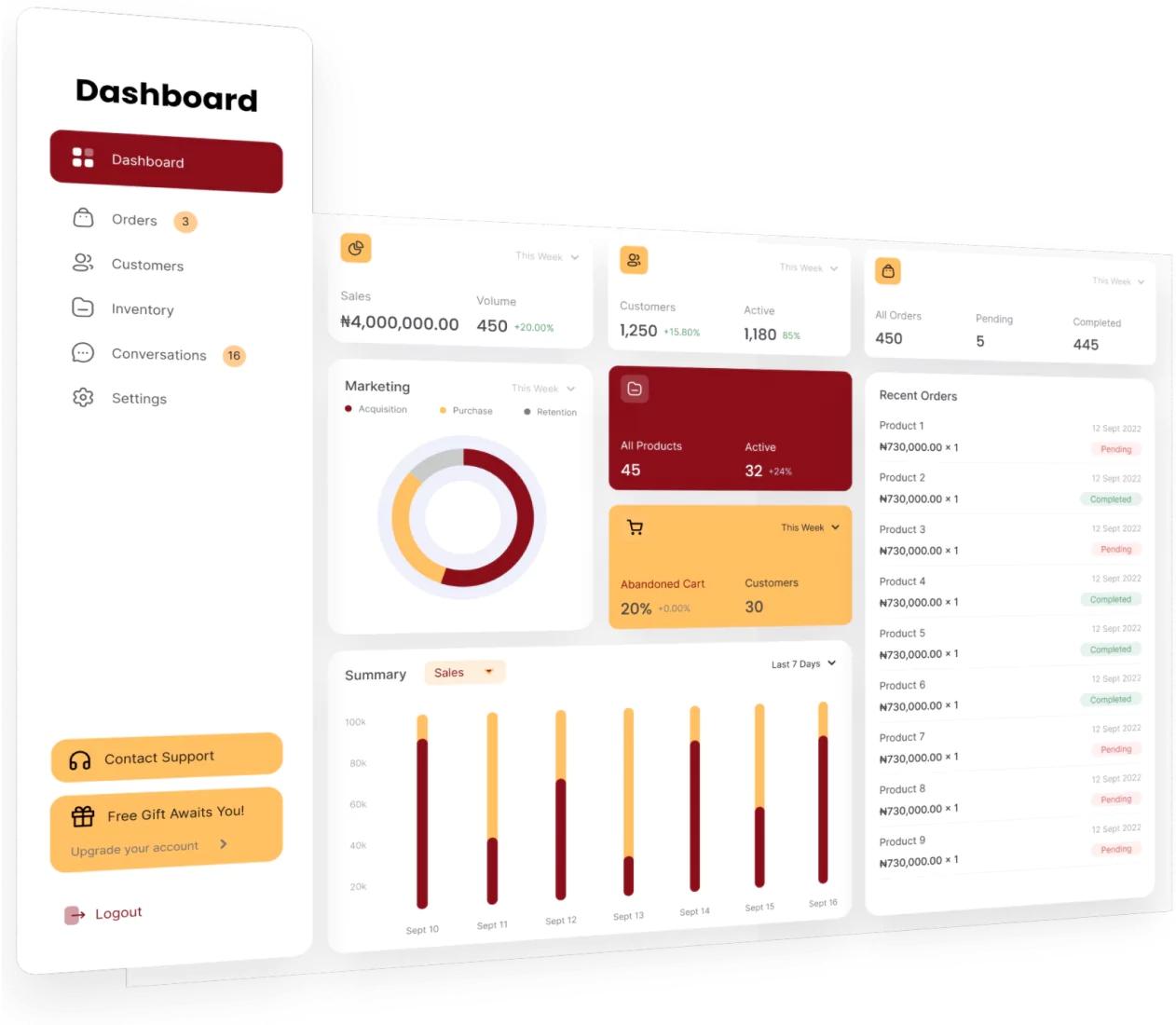Do you find keeping your company’s financial reports accurate and organized difficult? When done manually, it’s easy to make mistakes and even small errors can cause confusion, delays, or economic problems.
That’s why a trusted accounting system like HashMicro Accounting Software can make all the difference. It helps you record and manage financial data more accurately, so you can avoid common problems and work more efficiently.
This article will explain financial statements and why they’re essential for your business. You’ll also see how accurate reports can lead to better decisions and how the right software can make the process easier.
Key Takeaways
|
Table of Content
Content Lists

What are Financial Statements?
Financial statements are structured reports that summarize a company’s financial activities and position over a certain period usually monthly, quarterly, or annually.
They include key documents like the balance sheet, income statement, and cash flow statement, each offering insights into different aspects of the business.
These reports provide a comprehensive view of your financial performance, helping you assess profitability, cash availability, liabilities, and overall financial health.
Whether evaluating past results or planning for the future, financial statements are essential tools for making informed, strategic business decisions.
How Financial Reports Help You Monitor Financial Performance
Financial reports help businesses track their economic performance by presenting key data like revenue, expenses, profit, and cash flow in a clear, structured format.
These reports are typically prepared based on standard accounting principles, ensuring consistency and reliability across reporting periods. This allows leaders to see how the company is doing over time.
Regular reviews of these reports make it easier to compare actual results with targets, spot issues early, and make informed business decisions. They also help identify trends that support better budgeting and planning.
Financial reports are useful internally for large companies and essential for maintaining transparency with investors, regulators, and other stakeholders. Accurate reporting supports accountability and long term growth.
Why are Financial Statements Important?
Here’s how financial statements support better business decisions:
- Identify financial inefficiencies: If your revenue increases but profit margins shrink, it may indicate rising costs or pricing issues. This insight helps businesses reassess pricing strategies or streamline expenses.
- Control and manage spending: When actual expenses exceed the budget, financial statements make it easier to pinpoint which areas require cost-cutting or better expense control.
- Build trust with stakeholders: Investors, lenders, and partners use financial statements to evaluate a company’s financial health and long-term viability. Accurate reports enhance transparency and credibility.
- Ensure compliance with tax regulations: Financial statements are essential for tax reporting. Certain reports include estimates for future tax liabilities because tax rules may differ from standard accounting practices.
Elements of a Financial Statement

Knowing what financial reports contain is essential to fully understanding how financial reports support better decision-making. Each financial statement section offers a different perspective on your business’s financial health and performance.
Let’s look at the key elements of a complete financial statement.
1. Income statement
The income statement provides a clear view of a company’s profitability over a specific period by detailing its revenues, operating costs, and resulting net income.
Commonly referred to as the profit and loss statement, it reflects how well the business is performing financially.
This report typically includes:
- Revenue generated from the sale of products or services
- Business-related expenses such as operating and administrative costs
- Net profit, calculated after all expenses have been deducted
- Any gains or losses arising from activities outside core operations
2. Statement of retained earnings
The statement of retained earnings shows how a company’s net income is either reinvested into the business or distributed to shareholders over a certain period. It helps explain the changes in retained earnings from the beginning to the end of the reporting period.
This report is beneficial for understanding how much profit is kept within the company to support growth, pay off debt, or fund future projects rather than being paid out as dividends.
It also complements the income statement and balance sheet by linking profit performance with equity changes.
3. Notes to the financial statements
Notes to the financial statements provide additional information to support the main reports. They explain how specific figures were calculated, what accounting policies were used, and provide details on items like loans, assets, or unusual transactions.
These notes help readers understand the full picture behind the numbers, making it easier to assess the company’s financial condition with more confidence.
Who Needs Financial Statements and Reports?
Financial statements aren’t just documents for accountants. They’re essential tools used by various stakeholders to make informed decisions. Whether running a business, investing in one, or regulating it, these reports provide the insights needed to evaluate performance and plan.
- Business owners and executives
- Investors and shareholders
- Banks and lenders
- Regulatory authorities
- Internal teams (Finance, Operations, etc.)
- Auditors and external analysts

Understanding the Limitations of Financial Reports
Although financial statements offer valuable insight into a company’s financial standing, they are not without their challenges. Different readers may interpret the same data differently, leading to varying conclusions about a business’s overall health.
- For instance, some investors might consider stock buybacks a smart move, while others may consider reinvesting in long-term assets a better use of capital.
- One stakeholder might be comfortable with a company’s debt load, while another may see it as a red flag.
- Analyzing financial statements over several periods can help reveal performance patterns and show how the company compares to competitors.
While financial reports are essential to business evaluation, users should always interpret them with context, caution, and an understanding of their limitations.
Streamline Your Financial Reporting Process with HashMicro’s Accounting Solution

Managing financial records manually can quickly become time consuming and stressful. Tracking income, expenses and compiling accurate reports often leads to delays especially when figures don’t align and require rechecking.
Many companies are now turning to HashMicro’s accounting software in Malaysia to address these challenges. It simplifies financial statement, reduces the risk of human error, and offers real-time insights into your company’s financial performance.
The system is equipped with powerful features designed to support the preparation and analysis of financial statements:
- Detailed multi-level analysis: View financial data by branch, department, or project. Easily switch perspectives and compare performance across different areas of your business.
- Budget vs actual financial reports: Compare your actual financial outcomes with your planned budgets to spot gaps and adjust strategies accordingly.
- Profit & loss vs. budget and forecasts: Align your P&L statement with budgeted and forecasted figures to better understand how your projections measure up against real results.
- Cash flow tracking and forecasting: Keep a close eye on incoming and outgoing cash with in-depth reports and anticipate future cash requirements using forecasting tools.
Conclusion
Understanding financial statements isn’t just about compliance. It’s about gaining visibility into your company’s financial health. These reports help you monitor performance, control costs, and make strategic decisions with confidence.
However, managing financial data manually can lead to errors and missed insights. That’s where automation makes a difference. With HashMicro’s Accounting Software, your reports are generated accurately and in real time, giving you a clearer view of your cash flow, profit margins, and budget performance.
Whether you’re leading a growing company or managing complex operations, HashMicro helps simplify financial statement. Try the free demo today to explore how it works.

FAQ Financial Statement
-
What are the 4 main financial statements?
There are four basic types of financial statements used to do this: income statements, balance sheets, statements of cash flow, and statements of owner equity.
-
What is GAAP in finance?
Generally accepted accounting principles (GAAP) comprise a set of accounting rules and procedures used in standardized financial reporting practices. By following GAAP guidelines, compliant organizations ensure the accuracy, consistency, and transparency of their financial disclosures.
-
What is financial goodwill?
Goodwill is an intangible asset that’s created when one company acquires another company for a price greater than its net asset value. It’s shown on the company’s balance sheet like other assets.




































